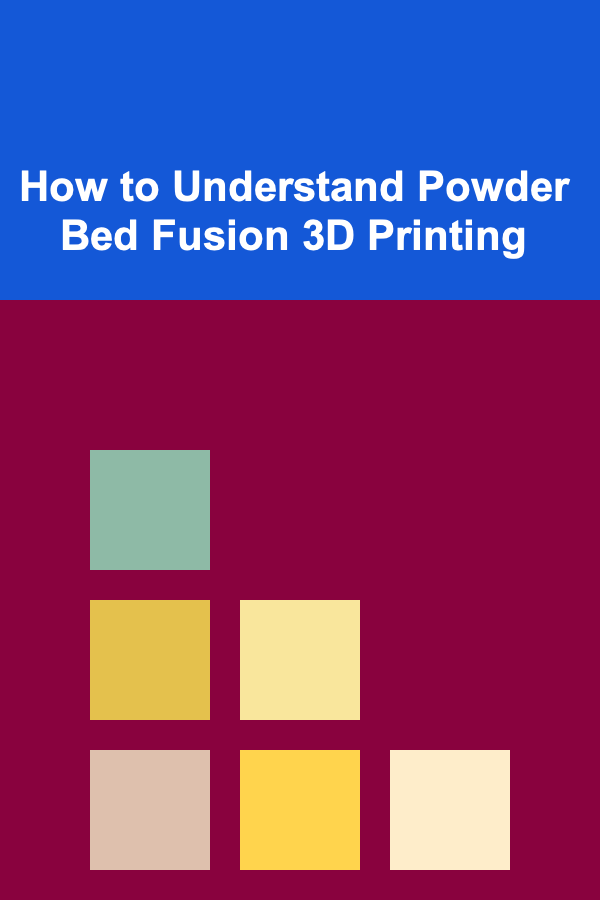
How to Understand Powder Bed Fusion 3D Printing
ebook include PDF & Audio bundle (Micro Guide)
$12.99$10.99
Limited Time Offer! Order within the next:

Powder Bed Fusion (PBF) is a category of 3D printing technologies that has revolutionized the manufacturing industry, providing unique capabilities for producing complex geometries and functional parts. It plays a significant role in industries such as aerospace, automotive, medical, and manufacturing due to its ability to create high-precision parts from a variety of materials, including metals, plastics, and ceramics. This article delves into the principles, processes, materials, applications, and advantages of Powder Bed Fusion 3D printing, offering a comprehensive understanding of this advanced technology.
What is Powder Bed Fusion (PBF)?
Powder Bed Fusion refers to a set of 3D printing techniques that build parts by selectively fusing powdered material together using heat. The process starts with a layer of fine powder spread evenly across a build platform. A heat source, typically a laser or electron beam, is directed at the powder, selectively fusing the powder particles according to the design specified in a 3D model. After each layer is fused, the platform is lowered, and another layer of powder is applied. This process is repeated until the part is fully built.
Unlike traditional subtractive manufacturing methods, where material is removed from a solid block, PBF creates parts by adding material layer by layer, allowing for the production of complex geometries that would be difficult or impossible to achieve through conventional methods.
Types of Powder Bed Fusion
There are several types of Powder Bed Fusion technologies, each differing in the method used to fuse the powder. The main types of PBF are:
-
Selective Laser Sintering (SLS): SLS uses a laser to sinter powdered material, such as plastic, metal, or ceramic, layer by layer. The laser selectively melts the powder particles together, solidifying them into a cohesive structure. SLS is commonly used for both prototyping and functional parts in industries like aerospace and automotive.
-
Selective Laser Melting (SLM): SLM is similar to SLS but is more commonly used with metals. In SLM, the laser fully melts the powder particles to form a solid part. This results in higher-density parts, which are often used in industries like aerospace and medical implants due to their excellent mechanical properties.
-
Electron Beam Melting (EBM): EBM uses an electron beam instead of a laser to melt the powder. It is typically used for metal powders, particularly titanium alloys. The electron beam offers a high-energy, focused beam capable of melting metal powders at high speeds. EBM is often used in the production of parts for the aerospace and medical industries.
-
Direct Metal Laser Sintering (DMLS): DMLS is another variant of laser-based powder bed fusion that works similarly to SLS, but it is specifically designed for metals. It uses a laser to sinter fine metal powders and is commonly used for manufacturing complex metal parts.
The Powder Bed Fusion Process
The PBF process consists of several key steps that work together to produce a finished part. These steps include:
1. Preparation of the 3D Model
The first step in the PBF process is to create a digital 3D model of the part. This model is typically designed using Computer-Aided Design (CAD) software and then converted into a file format compatible with 3D printing, such as STL or AMF. The 3D model is sliced into thin layers that guide the printing process.
2. Preparation of the Powder Bed
Once the 3D model is ready, a thin layer of powder is spread evenly across the build platform. The powder used depends on the material chosen, such as nylon, titanium, aluminum, or stainless steel. The powder bed is carefully prepared to ensure even distribution, which is crucial for achieving a high-quality final part.
3. Selective Fusing of the Powder
Using a laser or electron beam, the fusing process begins. The heat source selectively melts or sinters the powder in the areas specified by the 3D model. In the case of SLS and DMLS, the powder particles are sintered to a point where they fuse together, forming a solid layer. In SLM and EBM, the powder is fully melted to form a cohesive structure.
4. Layer-by-Layer Construction
After each layer is completed, the build platform is lowered by a small increment, and a new layer of powder is applied. The heat source then fuses the new layer according to the design. This process repeats for each layer until the part is fully built.
5. Cooling and Post-Processing
Once the part is printed, it must cool down before it can be removed from the build platform. After cooling, the part is typically subjected to post-processing steps, such as powder removal, support removal, and surface finishing. In some cases, additional heat treatment or machining is required to achieve the desired mechanical properties or finish.
Materials Used in Powder Bed Fusion
Powder Bed Fusion can accommodate a wide range of materials, making it highly versatile for different applications. These materials include metals, plastics, and ceramics, each with its specific properties and advantages.
1. Metals
Metals are one of the most common materials used in PBF, especially in industries like aerospace, automotive, and medical device manufacturing. Some of the metals commonly used in PBF include:
- Titanium Alloys: Titanium is widely used in aerospace and medical applications due to its excellent strength-to-weight ratio, corrosion resistance, and biocompatibility.
- Stainless Steel: Stainless steel is used in various applications, offering high strength, corrosion resistance, and durability.
- Aluminum Alloys: Aluminum is lightweight and corrosion-resistant, making it suitable for automotive and aerospace applications.
- Cobalt-Chromium Alloys: These alloys are often used in medical implants due to their strength, wear resistance, and biocompatibility.
2. Plastics
Plastics are often used in PBF for prototyping and low-volume production. Materials such as:
- Nylon (PA12, PA11): Nylon is a popular material due to its durability, strength, and flexibility. It is commonly used in industrial applications.
- Polyamide: Used for parts that require high strength and impact resistance.
- Polypropylene: Known for its chemical resistance and light weight, used in automotive and consumer products.
3. Ceramics
Ceramic powders are sometimes used in PBF for applications requiring high heat resistance, wear resistance, or specific aesthetic properties. These parts are often used in the aerospace industry and high-performance engineering applications.
Advantages of Powder Bed Fusion
Powder Bed Fusion offers several distinct advantages over traditional manufacturing methods, making it an attractive choice for many industries.
1. Complex Geometries
One of the most significant advantages of PBF is its ability to produce complex geometries that would be difficult, if not impossible, to manufacture with traditional methods. The layer-by-layer process allows for intricate designs, internal structures, and lightweight parts with minimal material waste.
2. Customization
PBF allows for high levels of customization in production. Since the process is based on a 3D model, it is easy to modify the design and produce parts with specific characteristics tailored to individual needs. This flexibility is particularly beneficial in industries like medical implants, where custom parts are often required.
3. Material Efficiency
In PBF, only the material that is needed to create the part is used. This contrasts with traditional manufacturing methods, which often involve removing material from a larger block. The ability to reuse unused powder further increases material efficiency, reducing waste.
4. Rapid Prototyping
PBF is highly effective for rapid prototyping, enabling designers and engineers to quickly create and test prototypes before moving to full-scale production. This reduces development time and costs, especially for products with complex designs.
5. Tool-less Manufacturing
Unlike traditional manufacturing methods that require molds, tooling, or specialized machines, PBF is a tool-less process. This reduces setup costs and allows for quick changes in design or production runs.
Applications of Powder Bed Fusion
The ability to create complex parts with high precision has made Powder Bed Fusion ideal for a wide range of applications across various industries.
1. Aerospace
In aerospace, where weight and material strength are critical, PBF is used to create lightweight, high-performance parts. Examples include engine components, brackets, and other structural elements that require specific material properties and complex geometries.
2. Medical
PBF is extensively used in the medical industry for creating custom implants, prosthetics, and surgical tools. The ability to manufacture parts with highly specific shapes and material properties makes it ideal for personalized medical devices, such as custom hip implants and dental crowns.
3. Automotive
The automotive industry uses PBF for producing low-volume parts, including specialized tools, brackets, and performance components. PBF enables rapid prototyping and small-batch production of customized parts, improving design flexibility.
4. Manufacturing and Consumer Products
Manufacturers in various sectors use PBF for producing complex parts and small-series production. Its ability to print parts with internal features or intricate structures makes it suitable for industries requiring high-precision components, such as electronics and consumer products.
Challenges and Limitations
Despite its many advantages, Powder Bed Fusion also comes with several challenges and limitations that need to be considered:
- Material Limitations: Although PBF can handle various materials, the range of available materials is still more limited than traditional manufacturing methods. The development of new powders and materials is ongoing.
- Surface Finish: Parts produced by PBF may have a rough surface finish that requires additional post-processing, such as polishing or coating, to achieve a smooth surface.
- Build Size: The size of parts that can be produced by PBF is limited by the size of the build platform, which can be restrictive for large-scale production.
Conclusion
Powder Bed Fusion 3D printing has emerged as a powerful technology for producing complex, high-quality parts with materials ranging from metals to plastics and ceramics. Its ability to create customized designs, reduce material waste, and enable rapid prototyping has made it invaluable across multiple industries, including aerospace, automotive, and healthcare. Despite challenges such as material limitations and post-processing requirements, the future of PBF is promising as technology advances and more materials are developed. As it continues to evolve, Powder Bed Fusion is expected to revolutionize traditional manufacturing and open up new possibilities for product design and production.

How to Create Effective Digital Presentations with Organization
Read More
How to Decorate Your Walls for Less
Read More
How to Expand Your Small Goods Store to Include Wholesale or Bulk Orders
Read More
How to Monitor Your Home Security Using Your Smartphone
Read More
Smart Discount Shopping: How to Save More on Every Purchase
Read More
How to Reduce Your Waste During the Holidays
Read MoreOther Products

How to Create Effective Digital Presentations with Organization
Read More
How to Decorate Your Walls for Less
Read More
How to Expand Your Small Goods Store to Include Wholesale or Bulk Orders
Read More
How to Monitor Your Home Security Using Your Smartphone
Read More
Smart Discount Shopping: How to Save More on Every Purchase
Read More